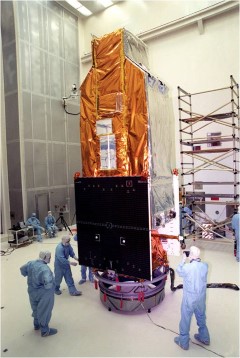The Far Ultraviolet Spectroscopic Explorer (FUSE): The FUSE satellite during final preparations for launch.
Credit: NASA
The spectral region from 900 to 1200 Å, commonly referred to as the far-UV, is not well covered by the UV instruments that have been aboard the HST, although the recent installation of COS now provides some sensitivity at far-UV wavelengths. The far-UV is one of the richest spectral regions of the entire electromagnetic spectrum for diagnostic spectroscopy. The Copernicus satellite did cover the far-UV but with a very inefficient single channel spectrum scanner. Because of the presence of absorption lines of H2, neutral deuterium, and O+5 in the far-UV, astronomers became very interested in gaining access to a much more sensitive far-UV observatory shortly after the Copernicus satellite stopped working in 1981. Many proposals were submitted to both NASA and the European Space Agency to build and operate in space a far-ultraviolet spectroscopic satellite. The primary scientific motivators for the observatory were: to study the abundance of deuterium (D), a by-product of nuclear processing in the Big Bang; to study O+5 in the Milky Way and in the IGM; and to probe the distribution of H2 throughout the Galaxy.
NASA finally agreed to fund the construction of the Far Ultraviolet Spectroscopic Explorer (FUSE) satellite in 1995. The 1400 kg FUSE satellite was launched in 1999 with a Delta II rocket and successfully operated until 2007. The FUSE program was run by astronomers at Johns Hopkins University and directed by Warren Moos. In order to achieve high efficiency at such short UV wavelengths, it was necessary to design a reflecting optical system employing silicon carbide (SiC) coatings on the optics for the shortest wavelengths and lithium flouride (LiF) coatings at the longer wavelengths. The observatory was designed to have the highest possible efficiency from 900 to 1200 Å in order to permit the observatory to observe relatively faint objects for the study of D, H2 and O+5.
The Delta Launch of FUSE in 1999: FUSE operated from 1999 to 2007 and was designed to obtain far-ultraviolet spectra over the wavelength range from 900 to 1195 Å. This spectral region is extremely rich in absorption lines from many atoms and molecules including tracers of hot (O+5) and cold (H2) interstellar gas and atomic deuterium, a product of nuclear processing in the Big Bang.
Credit: NASA



